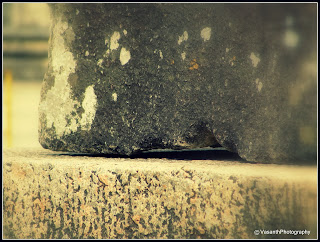Place
Name: Belur
Distance
from Bangalore: approx 200 KM from Majestic
Route:
Via Nelamangala, Mangalore route, go till Hassan and take Chikmagalur route
Duration:
1 day Trip
Road
Condition: Good
My frequent visits to Hassan gave me the opportunity to visit Belur and
capture the world’s best carvings. The threatening cyclonic weather was posing
a challenge for the visit. However the mild showers and the moderate weather
gave me the perfect day for photography. Reaching Belur, I headed towards the
very famous Channakeshava temple. The resplendent beauty of the temple reflects
through the Gopuram (Entrance of the temple).
Upon entering the temple, one can enquire about the guides and engage
one, to know more about the interesting history of the temple.
Historians have recorded that Belur was the early
capital of Hoysala dynasty. This temple is believed to be one of the finest
example of Hosyala Architecture. This was built by King Vishnuvardhana in
commemoration of his victory over the Cholas at Talakad in 1117 AD. The
grandson of Vishnuvardhana, Veera Ballala II complete the task of building the
temple. The splendid architecture took 103 years to be completed. The temple is
alluring with intricate carvings and beautiful sculptures and friezes with no
portion left blank. The intricate workmanship include Elephants(symbolizing the
strength), Lions(symbol of bravery), Horse(symbol of speed). One can also
notice the depiction of the Mahabharata and Ramayana epics on the walls of the
temple. The carvings of the sensuous dancers(Shilabalikas) captivates the
heart. There are 40 odd shilabalikas carvings and each one is distinct from the
other. It is The spectacular expression
on the face of the Shilabalikas is noticeable.
The temple is rich with the age old traditions and is also vaastu
compliant. The temple is built in a typical star formation which helps to
accommodate lot of sculptors, form a firm grip to the complete temple, and the
star represents the Shri Chakra formation.
There is 600 odd carvings of elephants around the
temple which is different in action. It is said that these carvings of the
temple is an inspiration for the Aksharadhama Temple (New Delhi).
There is a Rangastal inside the sanctorum of the
temple, where it is believed that the queen Shantaladevi (wife of
Vishnuvardhana) presented her dance before the lord. There are many ornate
pillars which is unique in designs and style. The famous carving of the Darpana Sundari (Lady with Mirror) is major
attraction and is believed to be inspired by the queen herself.
History believes that the carvings in the temple was
under the guidance of Maha shilpi Jakanachari. (Legend says that Dankanachari
(son of Jakanachari) found that the main statue of Lord Vishnu was faulty and
had frog inside it. Jakana, was shocked to believe this, cut his right hand
when it was proved. He vowed to build the other temple and contemplated the
task. The old temple is known as Kappechennigaraayas temple.). An interesting
feature that one can notice is that one of the pillar which houses almost all
the carvings around the temple. It is said that this pillar was built on
bearing system and was rotating. However, due to lightning which struck, this
cannot be noticed now. The pillars inside are magnificently carved with all
different designs. The main Santorum of the temple has the main deity of 12foot
long Chennakeshava idol of 8ft which is housed on 4ft of base. The Chennakeshva
idol is mesmerizing. The sculptors have taken care to ensure the adequate
aeration inside the temple. On a close observation, you can notice that the
temple is built on lock and key fashion. The ceiling is fantastically carved
with "Ugranarsimha" in the Center.
The depiction of the multistorey building has also
been carved ,where you see the space that is been left out in balcony. Sand
stone has been used for the sculptures which is said to have been bought from
Tumkur. There is one shilabalki inside whose bangle is been sculpted so well,
that the bangle can be moved even today. I have tried to capture it with flash
and I’m able to see the gap between the hand and the bangle .
Belur is so magnificently built and I see this has the
heaven of carvings. I spent almost 3 hours in Belur knowing and exploring the
sculptures and have always returned with the state of contentment and
appreciating the work of all the sculptors for the wonderful craftsman ship.
please do visit the following link for more description on each image
https://www.facebook.com/media/set/?set=a.1419890931556239.1073741831.1393567807521885&type=3&uploaded=30
































